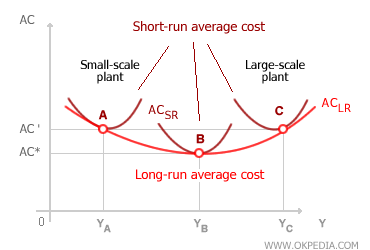Long-Run Average Cost
The long-run average cost is the total cost of production (C) divided by the quantity of output (Y). Unlike in the short run, where some inputs are fixed, all production factors are variable in the long run. This means there are no fixed costs since firms can adjust their production scale, adopt new technologies, and expand or shrink their facilities as needed. The long-run average cost curve (ACLR) can be visualized on a Cartesian graph, where it serves as the envelope of the short-run average cost curves (ACSR) associated with different plant sizes. In other words, it represents the lowest possible cost at which each level of output can be produced in the long run. The short-run average cost curves for individual plants are tangent to the long-run average cost curve.

The long-run average cost curve typically exhibits a U-shape. Depending on whether the curve slopes downward or upward, firms experience either economies or diseconomies of scale.
- Economies of scale. Economies of scale occur in the downward-sloping portion of the long-run average cost curve, where average cost falls as production increases. Expanding the scale of operations allows firms to spread fixed costs over a larger output, improve efficiency, and benefit from bulk purchasing and specialization. For example, curve A represents a small-scale plant. As the plant increases its capacity (Y), the long-run average cost (ACLR) declines.
- Diseconomies of scale. Diseconomies of scale arise in the upward-sloping portion of the long-run average cost curve, where increasing production leads to higher average costs. This typically happens due to coordination inefficiencies, rising labor costs, or logistical bottlenecks. For instance, curve C represents a large-scale facility that has exceeded its optimal size. Further expansion of capacity (Y) results in higher long-run unit costs (ACLR).
- Constant returns to scale. Constant returns to scale occur when a firm reaches the optimal plant size, achieving the minimum possible long-run average cost (ACLR). At this point, increasing or decreasing production capacity (Y) leads to higher unit costs, as shown at point B.
Understanding economies of scale in the long run. Long-run economies of scale arise for several reasons. As firms expand, they can take advantage of indivisible production factors, enhance operational efficiency, and gain stronger bargaining power in the market. However, these benefits exist only up to a certain point—beyond that, diseconomies of scale set in, increasing costs.
